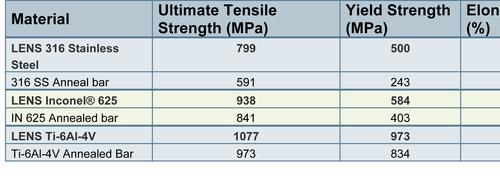Metals 3D Printer Gets a Smaller Footprint
June 25, 2013

Usually, we're telling you about bigger 3D printer build volumes, not smaller ones. But this is a bit different. Optomec has taken a highly sophisticated 3D printing process for metals and made it available in a smaller machine.
Engineers have been producing metal components, not just prototypes, for several years using Optomec's version of selective laser sintering (SLS), which the company calls LENS (Laser Engineered Net Shaping). The components built have been relatively large, with a process work envelope of 900 mm x 1,500 mm x 900 mm (35.43 inch x 59.0 inch x 35.43 inch) for the company's largest machine, the 850-R. That one deposits material such as standard steels, titanium, and nickel alloys at up to 500 g/hr (1.1 lb/hr).

Optomec says that for many applications the mechanical properties of components built with the process are equivalent to those of wrought metals. For example, independent testing has shown that the fatigue strength of Ti 6-4 matches the fatigue strength of wrought annealed material. Yield strength and tensile strength of the 3D-printed material were actually better at 973 MPa and 1077 MPa versus 834 MPa and 973 MPa, respectively, for Ti-6Al-4V, a titanium/aluminum alloy. Among other things, Ti-6Al-4V alloys are used for structural components on commercial aircraft.
Originally developed at Sandia National Laboratories, the LENS process has been used for prototyping and manufacturing military and aerospace components, as well as medical instruments and implants. It can be used for adding layers of metals to an existing component to improve its wear resistance, or add features to large cast components, such as a flange or boss. The process has also been optimized for repairing military and aerospace metallic components, such as restoring their inner diameters or inside blind holes. (Watch a video demonstrating the process below.)
The new machine, the LENS 450, is built with the same basic technology, but it has a much smaller process work envelope of 100 mm x 100 mm x 100 mm (3.94 inch x 3.94 inch x 3.94 inch). It also has a much slower (about 6.25 times slower) maximum deposition rate of 80 g/hr (2.82 oz/hr). It comes with a 400W fiber laser, a motion control system, and proprietary process control and part preparation software. The machine prints titanium, stainless steel, cobalt chrome, and superalloys.
So why would anyone want one of these? Interestingly, Optomec says it has developed this model to help proliferate the use of metals in additive manufacturing. The company is aiming the printer at university mechanical and materials engineering departments and labs, for the purpose of training the next generation of engineers in AM, and specifically, AM with metals.
The first machine will be delivered to the University of Pittsburgh's department of mechanical engineering and materials science, for use in the department's advanced manufacturing program. The university is a member of the federally sponsored National Additive Manufacturing Innovation Institute (NAMII). Wouldn't it be interesting if this became a trend?
Related posts:
About the Author(s)
You May Also Like



